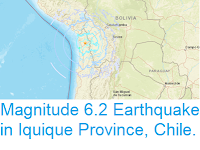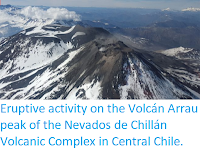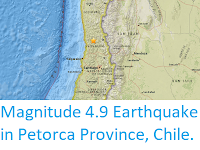The United States Geological Survey
recorded a Magnitude 6.7 Earthquake at a depth of 53.0 km, off the coast of Elqui Province in central Chile, slightly after 10.30 pm local time on Saturday 19 January 2019 (slightly after 1.30 am GMT on Sunday 20 January GMT). The Earthquake is reported to have caused only minor damage, but two people died of heart attacks in the city of Coquimbo, 15 km to the northeast of the Earthquake's epicentre. It was initially feared that the event might have triggered a tsunami, but this did not occur.
The approximate location of the 19 January 2019 Elqui Province Earthquake. USGS.
Chile is located on the west coast of South America, which is also the
convergent margin between the Nazca and South American Plates. The Nazca
Plate is being subducted beneath the South American Plate and is
sinking beneath the South American Plate. This is not a smooth process,
the rocks of the two plates continuously stick together then, as the
pressure builds up, break apart again, causing Earthquakes. As the Nazca
Plate sinks deeper it is partially melted by the heat of the Earth's
interior. Some of the melted material then rises up through the
overlying South American Plate as magma, fuelling the volcanoes of the
Chilean Andes.
The subduction of the Nazca Plate beneath the South American Plate, and how it causes Earthquakes and volcanoes. Pacific Earthquake Engineering Research Center.
Earthquakes
along subductive margins are particularly prone to causing tsunamis,
since these often occur when the overlying plate has stuck to the
underlying plate, being pulled out of shape by its movement.. Eventually
the pressure builds up to far and the overlying plate snaps back,
causing an Earthquake and a tsunami.
Witness
accounts of Earthquakes can help geologists to understand these events,
and the structures that cause them. The international non-profit
organisation Earthquake Report is interested in hearing from people who may have felt this event; if you felt this quake then you can report it to Earthquake Report here.
See also...
Follow Sciency Thoughts on
Facebook.









